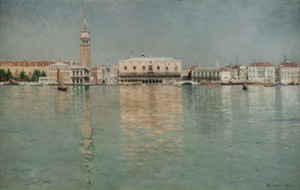
Today, images of other “worlds” are only a click away, but in the late 19th and early 20th centuries, the experience required extensive travel. In the late 1800s and early 1900s, American artists flocked to the then center of the art world, Paris, to study and to the Mediterranean to record the exotic worlds of the varied and ancient cultures of Egypt, Greece, Italy, Spain, France, Northern Africa and the Holy Land.
American tourism of Europe before the Civil War usually followed that of the Grand Tour, which included all the important cultural centers of France, Italy and Germany, but in the late 19th century, American artists showed increasing interest in points abroad, including Spain, the Holy Land, Egypt and much of northern Africa. American artists became interested in the aspects of nature and culture that they believed defined the Mediterranean: its distinctive flora, the legacy of the Greco-Roman past and the influence of Christianity and Islam.
The reasons for this expanded awareness are numerous.
Popular travel writers such as George William Curtis, Bayard Taylor and Mark Twain attracted American attention to North Africa and the Middle East. Some American artists were encouraged to visit Spain, the Middle East and Africa by their European teachers. Wealthy collectors also drew artists to popular vacation spots such as Venice and the Nile River. Religious faith prompted Americans to visit the Holy Land and other sites important to their beliefs.
While the respective reasons for Mediterranean travel differed among American artists, the visual records of their travels demonstrate a growing awareness of a palpable unity in the region. Mediterranea provides contemporary viewers with an exploration of the ways American artists understood, interpreted and portrayed Mediterranean culture in the late 19th and early 20th centuries.
The exhibition from the collection of rare and little-known examples of late 19th century American painting is a result of collector Graham D. Willford’s search for a national artistic identity through “American” styles. Williford received a bachelor of arts degree in art history from Columbia University in New York City. Following graduate studies, he went to Paris, France, and discovered how early American artists modeled the nation’s fledgling art institutions and academies on European models. This exhibition also addresses the ways in which American art later struggled to create its own traditions, away from the looming influence of the Old World.
When American museums and galleries only concentrated on nationalistic subject matter, Williford daringly explored the international exchange between America and Europe.
This exhibition of selections from Graham D. Williford’s vast collection allows us to investigate the important and richly textured history of American artists working, exhibiting and studying abroad in the critical, final decade of the 19th century.




























Leave a Reply